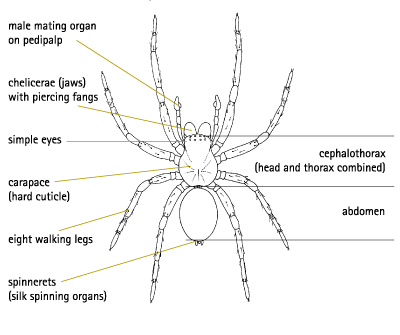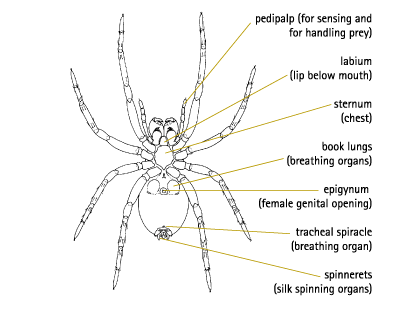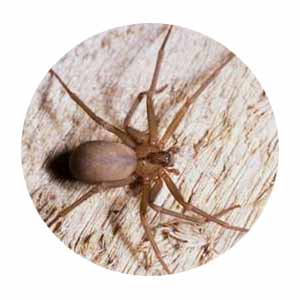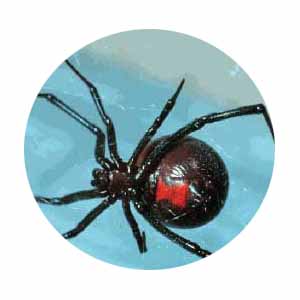| What are Spiders? |
Spiders are arachnids not insects, but both spiders and insects belong to the largest group of animals on Earth, the arthropods - animals with hard external skeletons and jointed limbs (greek arthro = joint, podos = footed).
Spiders have eight legs (four pairs). They have two body regions: a cephalothorax (fused head and thorax) and an abdomen, which are joined together by a narrow waist. Most spiders have six or eight simple eyes in various arrangements. All have a pair of jaw-like structures, the chelicerae, each of which ends in a hollow fang through which venom can be ejected. The tip of the abdomen has a group of small fingerlike spinnerets that produce silk. Young spiders (spiderlings) resemble adults except for their smaller size and coloration. |

Male Spider
|
The male spider's primary objective in life is to impregnate one or more female spiders before other males can. As it turns out, this is no easy task in most species.
The first obstacle is actually finding a female spider. Most spider species are completely solitary animals, meaning they live and feed on their own, and they are generally spread out over a wide area, making an available female relatively scarce. The male spider has the daunting task of tracking down a sexually mature, receptive female in the area before other males can get there. |
In most species, the female makes it easier on the males by "advertising" herself with pheromones , communicative chemicals. Many female ground spiders will secrete a pheromone on their dragline , the silk thread they leave trailing behind them. When males of the same species come across the dragline, they smell the pheromone with the chemical sensors on their front legs and follow the dragline to the female.
Web-spinning females may release pheromones directly into the air or coat their webs with pheromones, to make a natural "chemical antenna." Males may also stake out developing, sexually immature female spiders, so they can be the first to mate after the spider's final molt. Once the male locates a female, it has to contend with any other males in the area. In species where the female spins a pheromone-coated web, the male's first order of business is to destroy the web to cut off the signal attracting any other males. If other males are present, the spiders in most species will fight it out for the right to copulate with the female.
After taking care of any other male contenders, the spider's next task is to deal with the female spider itself. Male spiders are generally much smaller than females in their species, making them easy prey. The male has to signal to the female that it is a spider of the same species, not food or a potential predator, and that it intends to copulate. This is courtship. |
Courtship varies considerably among different species. Many web-building spiders will use vibration as a means of courtship communication. The male may strum a unique signal on a thread connected to the female's web to identify itself and get across its intentions. Many spiders with better eyesight, such as various wolf spiders and jumping spiders, will "dance" to court the female.
Once the female recognizes the male's courtship behavior, she will position herself for sex, signaling to the male that she is receptive,
|

Female Spider
|
or she will make it clear that she is not receptive (by shaking her web, for example, or just crawling away). If the male is desperate to mate, because all the females in the area will soon lay their eggs, he may proceed anyway, with full understanding that the female might kill him.
Both the male and female reproductive organs are at the rear of the abdomen, but spiders don't mate by coupling these organs. Instead, the male deposits some sperm onto a small web and picks it up on the end of his pedipalps. When the female is in position, the male deposits the sperm in the female's genital opening. The female stores the sperm in receptacles near the ovaries. When she is ready to lay her eggs, months down the road in some species, she uses the sperm to fertilize them. Some spiders may lay hundreds, even thousands of eggs in one shot. |

Brown Recluse
|
FEAR THESE SPIDERS |

Black Widow
|
Many people are afraid of spiders. This fear is partly due to myths and to the notoriety of harmful species such as the brown recluse spider and the black widow spider. Several species of sac spiders (clubionids) are suspected of being responsible for most spider bites, especially ones occurring indoors. Sac spider venom is cytotoxic, causing tissues at the bite site to die. However, the vast majority of spiders are harmless to humans.
Although spiders are often unpopular, the venom of most species is not very toxic to humans, usually resulting in no more than a slight swelling, inflammation, or itching sensation. Most spiders’ fangs are too small or weak to puncture human skin. Spiders usually will not attempt to bite unless accidentally trapped against the skin or grasped, although some species actively guard their egg sacs or young.
Preventing spider bites
- Shake out clothing and shoes before getting dressed.
- Inspect bedding and towels before use.
- Wear gloves when handling firewood, lumber, and rocks (be sure to inspect the gloves for spiders before putting them on).
- Remove bed skirts. Move the bed away from the wall.
- Don’t store boxes and other items underneath beds.
- Exercise care when handling cardboard boxes (some spiders may inhabit the space under folded cardboard flaps).
For Exterminating Spiders
|
|





